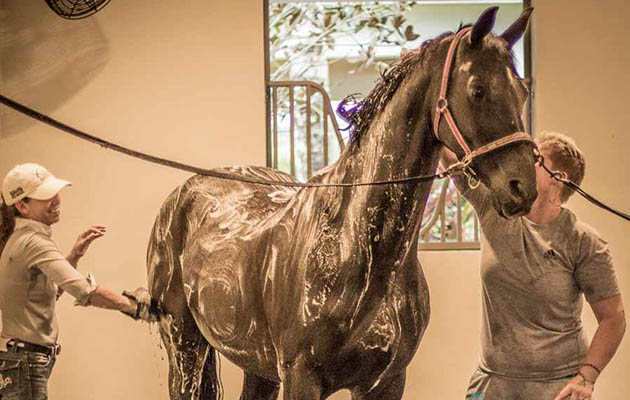Owners of horses who test “non-negative” for certain diseases on their arrival in the US can be told the animals must either be deported, at high cost, or put down. H&H speaks to some of those affected, US authorities and other experts...
A call has been made for change to the “euthanise or deport” protocol for horses who test “non-negative” for certain equine diseases on arrival in the US following recent cases.
Equines are tested for piroplasmosis (a tick-borne disease), dourine (parasitic venereal disease, eradicated in many countries), glanders and equine infectious anaemia (EIA) on arrival in the country. The vast majority of the thousands of horses who arrive from abroad test negative and pass through the border with no issue.
For the few who give false positives or “non-negative” tests – the phrase used by the US Department of Agriculture (USDA) Animal and Plant Health Inspection Service (APHIS) to describe anything that is not clearly a negative test – the repercussions have significant moral and financial consequences for owners.
The USDA has told H&H it is “reviewing the current protocol”.
{"content":"PHA+U2VsbGVyIFBldGVyIGRlIEJvZXIgbWFkZSB0aGUgY2FsbCBmb3IgY2hhbmdlIGxhc3QgbW9udGgsIGFmdGVyIGEgaG9yc2UgaGUgc2hpcHBlZCBmcm9tIHRoZSBOZXRoZXJsYW5kcyB0byB0aGUgVVMgdHdpY2UgdGVzdGVkIG5vbi1uZWdhdGl2ZSBmb3IgZG91cmluZSwgZm9yIHdoaWNoIHRoZSBob3JzZSBoYWQgdGVzdGVkIG5lZ2F0aXZlIGJlZm9yZSBkZXBhcnR1cmUuIFRoZSBkaXNlYXNlIGhhcyBiZWVuIGVyYWRpY2F0ZWQgaW4gbXVjaCBvZiBFdXJvcGUsIGluY2x1ZGluZyB0aGUgTmV0aGVybGFuZHMsIGFuZCB0aGlzIGdlbGRpbmcgaGFzIG5ldmVyIGJlZW4gdXNlZCBmb3IgYnJlZWRpbmcuIEhlIHdhcyB0b2xkIHRoYXQgdGhlIGhvcnNlIG11c3QgYmUgZGVwb3J0ZWQgb3IgcHV0IGRvd24uPC9wPgo8cD48ZGl2IGNsYXNzPSJhZC1jb250YWluZXIgYWQtY29udGFpbmVyLS1tb2JpbGUiPjxkaXYgaWQ9InBvc3QtaW5saW5lLTIiIGNsYXNzPSJpcGMtYWR2ZXJ0Ij48L2Rpdj48L2Rpdj48c2VjdGlvbiBpZD0iZW1iZWRfY29kZS0zMSIgY2xhc3M9ImhpZGRlbi1tZCBoaWRkZW4tbGcgcy1jb250YWluZXIgc3RpY2t5LWFuY2hvciBoaWRlLXdpZGdldC10aXRsZSB3aWRnZXRfZW1iZWRfY29kZSBwcmVtaXVtX2lubGluZV8yIj48c2VjdGlvbiBjbGFzcz0icy1jb250YWluZXIgbGlzdGluZy0tc2luZ2xlIGxpc3RpbmctLXNpbmdsZS1zaGFyZXRocm91Z2ggaW1hZ2UtYXNwZWN0LWxhbmRzY2FwZSBkZWZhdWx0IHNoYXJldGhyb3VnaC1hZCBzaGFyZXRocm91Z2gtYWQtaGlkZGVuIj4NCiAgPGRpdiBjbGFzcz0icy1jb250YWluZXJfX2lubmVyIj4NCiAgICA8dWw+DQogICAgICA8bGkgaWQ9Im5hdGl2ZS1jb250ZW50LW1vYmlsZSIgY2xhc3M9Imxpc3RpbmctaXRlbSI+DQogICAgICA8L2xpPg0KICAgIDwvdWw+DQogIDwvZGl2Pg0KPC9zZWN0aW9uPjwvc2VjdGlvbj48L3A+CjxwPkluIGEgc2VwYXJhdGUgY2FzZSBpbiBNYXksIFVLIHNlbGxlciBCZWNraSBKb25lcyBzb2xkIGEgc2hvd2p1bXBlciB0byB0aGUgVVMgb24gYmVoYWxmIG9mIGEgY2xpZW50IGFuZCwgYXMgcGFydCBvZiBkdWUgZGlsaWdlbmNlLCBibG9vZCBzYW1wbGVzIHdlcmUgdGFrZW4gaW4gdGhlIFVLIGJlZm9yZSBkZXBhcnR1cmUsIHdoaWNoIGNhbWUgYmFjayB3aXRoaW4gdGhlIHBlcm1pdHRlZCBsZXZlbHMgZm9yIHBpcm9wbGFzbW9zaXMuPC9wPgo8cD5PbiBhcnJpdmFsIGluIHRoZSBVUywgdGhlIGhvcnNlIHR3aWNlIHRlc3RlZCBub24tbmVnYXRpdmUgZm9yIHRoZSBkaXNlYXNlIGFuZCB0aGV5IHdlcmUgZ2l2ZW4gdGhlIOKAnGRlcG9ydCBvciBkZXN0cm954oCdIG9wdGlvbi48L3A+CjxwPkFmdGVyIHRha2luZyB0aGUgY2FzZSB0byBDb25ncmVzcywgdGhlIGhvcnNlIHdhcyBwZXJtaXR0ZWQgdG8gaGF2ZSBhIHRoaXJkIHRlc3QsIHdoaWNoIHdhcyBhbHNvIG5vbi1uZWdhdGl2ZS4gSGUgd2FzIGZsb3duIGJhY2sgdG8gRnJhbmNlLCB3aGVyZSBoZSB0ZXN0ZWQgbmVnYXRpdmUuPC9wPgo8ZGl2IGNsYXNzPSJhZC1jb250YWluZXIgYWQtY29udGFpbmVyLS1tb2JpbGUiPjxkaXYgaWQ9InBvc3QtaW5saW5lLTMiIGNsYXNzPSJpcGMtYWR2ZXJ0Ij48L2Rpdj48L2Rpdj4KPHA+4oCcSSBkb27igJl0IHVuZGVyc3RhbmQgdGhlIGxvZ2ljLOKAnSBNcyBKb25lcyB0b2xkIDxlbT5IJmFtcDtIPC9lbT4sIGFkZGluZyB0aGF0IHNoZSBkb2VzIG5vdCB1bmRlcnN0YW5kIHdoeSBob3JzZXMgY2Fubm90IGJlIGtlcHQgaW4gcXVhcmFudGluZSB0byBiZSByZXRlc3RlZC4g4oCcSXTigJlzIG5vdCBpbiB0aGUgaG9yc2XigJlzIGJlc3QgaW50ZXJlc3QgW3RvIGJlIHB1dCBkb3duIG9yIHB1dCBiYWNrIG9uIGEgbG9uZyBmbGlnaHRdLiBUaGUgcXVhcmFudGluZSBmYWNpbGl0eSBpcyB0aGVyZSBmb3IgYSByZWFzb24sIGl04oCZcyBub3QgY29zdGluZyB0aGVtIGFueXRoaW5nLCBpdCBpcyB0aGUgY29zdCB0byB0aGUgb3duZXIu4oCdPC9wPgo8aDM+QSBtb3JhbCBhbmQgZmluYW5jaWFsIGRpbGVtbWE8L2gzPgo8cD7igJxbRGVwZW5kaW5nIG9uIGFuIG93bmVyc+KAmSBmaW5hbmNpYWwgc2l0dWF0aW9uXSwgdGhleSBjYW4gZmluZCB0aGVtc2VsdmVzIGluIGEgcGxhY2Ugd2hlcmUgdGhleSBjYW5ub3QgYWZmb3JkIHRvIHNlbmQgdGhlbSBiYWNrLCBidXQgY2Fubm90IGJyaW5nIHRoZW1zZWx2ZXMgdG8gZXV0aGFuaXNlIGEgcGVyZmVjdGx5IGhlYWx0aHkgaG9yc2UuIFRoYW5rZnVsbHkgaXQgb25seSBhZmZlY3RzIGEgZmV3LCBidXQgZm9yIHRob3NlIGZldyBpdCBpcyBhIHZlcnkgZW1vdGlvbmFsIGRpbGVtbWEs4oCdIFNjYXJsZXR0ZSBHb3R3YWxzLCB2ZXQgYW5kIGRpcmVjdG9yIG9mIGZsaWdodCBvcGVyYXRpb25zIGF0IGludGVybmF0aW9uYWwgaG9yc2UgdHJhbnNwb3J0IGNvbXBhbmllcyBIb3JzZSBBbWVyaWNhIGFuZCBCcm9va2UgTGVkZ2UsIHRvbGQgPGVtPkgmYW1wO0guPC9lbT48L3A+CjxkaXYgY2xhc3M9ImFkLWNvbnRhaW5lciBhZC1jb250YWluZXItLW1vYmlsZSI+PGRpdiBpZD0icG9zdC1pbmxpbmUtNCIgY2xhc3M9ImlwYy1hZHZlcnQiPjwvZGl2PjwvZGl2Pgo8cD5TaGUgYWRkZWQgdGhpcyBpcyBub3QgYSBjYXNlIG9mIHRoaXMgaGFwcGVuaW5nIHRvIG9uZSB0cmFuc3BvcnRlciBhbmQgbm90IG90aGVycywgYnV0IGlzIGFuIGlzc3VlIHdpdGggdGhlIGNob2ljZSBvZiB0ZXN0aW5nIGFuZCBob3cgdGhlIGlzc3VlIGlzIGhhbmRsZWQgYnkgdGhlIFVTREEuPC9wPgo8cD5EciBHb3R3YWxzIGV4cGxhaW5lZCB0aGlzIGlzIG93aW5nIHRvIHRoZSBmYWN0IHRoYXQgdGhlIG1ldGhvZCB1c2VkIGludm9sdmVzIHNjcmVlbmluZyB0ZXN0aW5nLCByYXRoZXIgdGhhbiBkaWFnbm9zdGljIHRlc3RpbmcuIFRoZSBkaWZmZXJlbmNlIGlzIGEgc2NyZWVuaW5nIHRlc3QgaXMgdG8gZGV0ZWN0IHBvdGVudGlhbCBkaXNlYXNlIGluZGljYXRvcnMsIHdoZXJlYXMgYSBkaWFnbm9zdGljIHRlc3QgZXN0YWJsaXNoZXMgdGhlIHByZXNlbmNlIChvciBhYnNlbmNlKSBvZiBhIGRpc2Vhc2UuPC9wPgo8ZGl2IGNsYXNzPSJhZC1jb250YWluZXIgYWQtY29udGFpbmVyLS1tb2JpbGUiPjxkaXYgaWQ9InBvc3QtaW5saW5lLTUiIGNsYXNzPSJpcGMtYWR2ZXJ0Ij48L2Rpdj48L2Rpdj4KPHA+4oCcV2UgYXJlIG5vdCB0YWxraW5nIGFib3V0IGhvcnNlcyB0aGF0IHRydWx5IGhhdmUgdGhlc2UgZGlzZWFzZXMs4oCdIHNoZSBzYWlkLCBhZGRpbmcgdGhlc2UgYXJlIGNhc2VzIHdoZXJlIGZvciBzb21lIHJlYXNvbiwgbGlrZWx5IGFzIGEgcmVzdWx0IG9mIHN0cmVzcyBvZiB0cmF2ZWxsaW5nLCB0aGUgaG9yc2Vz4oCZIHNhbXBsZXMgdGFrZW4gb24gYXJyaXZhbCBhcmUgcHJlc2VudGluZyBhIGZhbHNlIHBvc2l0aXZlLjwvcD4KPHA+4oCcTm9ib2R5IGlzIHN1Z2dlc3RpbmcgdGhleSB3YW50IHRvIHB1dCB0aGUgbmF0aW9uYWwgaGVyZCBhdCByaXNrLCB3ZSBhcmUgbm90IGFza2luZyBmb3IgaG9yc2VzIHRvIGJlIHJlbGVhc2VkIHdpdGhvdXQgY2xlYXIgdGVzdGluZywgYnV0IGZvciB0aW1lIHNvIHRoZXkgY2FuIGdldCBhIG5lZ2F0aXZlIHRlc3QgW2luc3RlYWQgb2YgYmVpbmddIGZsb3duIGFsbCB0aGUgd2F5IGJhY2sgdG8gRXVyb3BlLuKAnTwvcD4KPHA+RHIgR290d2FscyBhZGRlZCB0aGF0IHRoZSBVU0RBIGlzIGNvbnNpZGVyaW5nIG1vZGlmeWluZyB0aGUgcHJvdG9jb2wgdG8gcGVybWl0IOKAnG5vbi1uZWdhdGl2ZeKAnSBob3JzZXMgdG8gcmVtYWluIGluIHF1YXJhbnRpbmUgYW5kIHJldGVzdCBpbiBhbm90aGVyIDE0IGRheXMsIHdpdGggdGhlIGNoYW5jZSBmb3IgYW4gYWRkaXRpb25hbCAxNCBkYXlzIGJlZm9yZSBhbm90aGVyIHJldGVzdC4gQXQgdGhhdCBwb2ludCBpZiB0aGUgYW5pbWFsIHN0aWxsIHRlc3RzIG5vbi1uZWdhdGl2ZSwgaXQgd2lsbCBiZSBkZW5pZWQgZW50cnkuPC9wPgo8cD5UaGVyZSBpcyBwcmVjZWRlbnQgZm9yIHRoZSByZWd1bGF0aW9ucyBiZWluZyBjaGFuZ2VkIHRvIGFsbG93IGZvciBtb3JlIHRpbWUsIGFzIHRoZSBwcm90b2NvbCBmb3IgaG9yc2VzIHRlc3Rpbmcgbm9uLW5lZ2F0aXZlIGZvciBnbGFuZGVycyB3YXMgYWx0ZXJlZCBzZXZlcmFsIHllYXJzIGFnbyB0byBhbGxvdyBmb3IgYWRkaXRpb25hbCB0aW1lIGFuZCBtb3JlIHJldGVzdHMuPC9wPgo8cD5CdXQgdGhlIHRpbWVzY2FsZXMgYXJlIG11Y2ggc2hvcnRlciBmb3IgZXF1aW5lcyB3aG8gcHJlc2VudCBub24tbmVnYXRpdmVzIGZvciBwaXJvcGxhc21vc2lzLCBkb3VyaW5lIG9yIEVJQS48L3A+CjxwPkEgc3Bva2VzbWFuIGZvciB0aGUgVVNEQSBBUEhJUyB0b2xkIDxlbT5IJmFtcDtIPC9lbT4gZmV3ZXIgdGhhbiAxJSBvZiB0aGUgMzksMDAwIGhvcnNlcyBpbXBvcnRlZCB0byB0aGUgVVMgdGhyb3VnaCBhaXJwb3J0cyBzaW5jZSAyMDE2IGhhdmUgcmVjZWl2ZWQgbm9uLW5lZ2F0aXZlIHJlc3VsdHMgZHVyaW5nIGltcG9ydCBxdWFyYW50aW5lLjwvcD4KPHA+4oCcVVNEQSBlcXVpbmUgaW1wb3J0IHRlc3RpbmcgcHJvdG9jb2wgaXMgbm90IGludGVuZGVkIHRvIGRpYWdub3NlIGluZGl2aWR1YWwgY2xpbmljYWwgb3Igc3ViY2xpbmljYWwgY2FzZXMs4oCdIGhlIHNhaWQuIOKAnFJhdGhlciwgaXQgaXMgYSByaXNrIGFzc2Vzc21lbnQgYW5kIGF2b2lkYW5jZSBtZWFzdXJlIHRvIHByb3RlY3QgdGhlIFVTIGVxdWluZSBwb3B1bGF0aW9uIGZyb20gZGlzZWFzZSBpbnRyb2R1Y3Rpb24uPC9wPgo8cD7igJxSZWFjdGlvbnMgdG8gdGhlIHRlc3QgY29tcGxldGVkIHdoaWxlIGhvcnNlcyBhcmUgaW4gaW1wb3J0IHF1YXJhbnRpbmUgY291bGQgYmUgZHVlIHRvIG11bHRpcGxlIGNvbXBvbmVudHMgaW5jbHVkaW5nIGVsZXZhdGVkIHNlcnVtIGNvbXBvbmVudHMsIHNoaXBwaW5nIHN0cmVzcyBvciBjcm9zcyByZWFjdGlvbnMgZHVlIHRvIGluZmVjdGlvbiB3aXRoIG90aGVyIGFnZW50cy48L3A+CjxwPuKAnEFsbCBob3JzZXMgaW1wb3J0ZWQgcmVxdWlyaW5nIHF1YXJhbnRpbmUgZm9sbG93IHRoZSBlc3RhYmxpc2hlZCB0ZXN0aW5nIHByb3RvY29sLiBUZXN0IHJlc3VsdHMgYXJlIHVzZWQgYXMgYSByaXNrIGFzc2Vzc21lbnQgdG93YXJkIHBvdGVudGlhbCBleHBvc3VyZSB0byB0aGUgZG9tZXN0aWMgZXF1aW5lIHBvcHVsYXRpb24u4oCdPC9wPgo8cD5IZSBhZGRlZCB0aGUgdGVzdGluZyBwcm90b2NvbCBpcyBleHRlbnNpdmVseSByZXZpZXdlZCBhbW9uZyBzdGF0ZSBhbmltYWwgaGVhbHRoIG9mZmljaWFscywgbGFib3JhdG9yeSBwZXJzb25uZWwsIGFuZCBVU0RBIGVxdWluZSBoZWFsdGggY29tbW9kaXR5IHN0YWZmLjwvcD4KPHA+4oCcVGhlcmVmb3JlLCB3ZSBhcmUgY29uZmlkZW50IGluIG91ciBwcmVjYXV0aW9uYXJ5IG1lYXN1cmVzIHRvIGtlZXAgdGhlIFVuaXRlZCBTdGF0ZXMgZnJlZSBvZiBkaXNlYXNlLOKAnSBzYWlkIHRoZSBzcG9rZXNtYW4uPC9wPgo8ZGl2IGNsYXNzPSJpbmplY3Rpb24iPjwvZGl2Pgo8cD7igJxTdGlsbCwgdGhlIFVTREEgaXMgcmV2aWV3aW5nIHRoZSBjdXJyZW50IHByb3RvY29sIGluIGNvbmp1bmN0aW9uIHdpdGggdGhlIHN0YXRlIGFuaW1hbCBoZWFsdGggb2ZmaWNpYWxzIHRvIGVuc3VyZSBpbmZvcm1hdGlvbiBpcyBwcm92aWRlZCBjbGVhcmx5IHdpdGggY29uc2lzdGVudCBleHBlY3RhdGlvbnMgZm9yIHRlc3RpbmcuIFdlIHdpbGwgYXBwcm9wcmlhdGVseSBpbmZvcm0gdGhlIGVxdWluZSBpbmR1c3RyeSBpZiB0aGVyZSBhcmUgYW55IHJldmlzaW9ucyB0byB0aGUgY3VycmVudCBwcm90b2NvbCBsYW5ndWFnZSBhcyBzb29uIGFzIG91ciByZXZpZXcgaXMgY29tcGxldGVkLuKAnTwvcD4KPHA+Cg=="}
You may also be interested in…
Credit: Al Guden
Sagacious HF enjoys a bath after returning home following his time in quarantine
Library image.
Elite event riders competing in France last weekend when new quarantine requirements were brought in at short notice will not
British horses make use of new quarentine facility in Chicago ahead of Rolex Kentucky three-day event
Credit: G Ashton-Coulton
Library image.
Credit: Alamy Stock Photo
News from the recent FEI general assembly includes the latest clean sport initiatives and wearing protective helmets when mounted to
Stay in touch with all the news in the run-up to and throughout the major shows and events during 2025 and beyond with a Horse & Hound subscription. Subscribe today for all you need to know ahead of these major events, plus online reports on the action as it happens from our expert team of reporters and in-depth analysis in our special commemorative magazines. Have a subscription already? Set up your unlimited website access now
H&H senior news writer
Lucy is an experienced news journalist, reporter and presenter. Since joining the Horse & Hound team in 2015, Lucy has reported from major global sporting events including the Tokyo Paralympic Games and multiple European Championships, as well as Badminton, Burghley and London, to name a few. She has covered current affairs and sports news across the full spectrum of equestrian disciplines and racing, as well as human and equine welfare, industry news and court cases.






